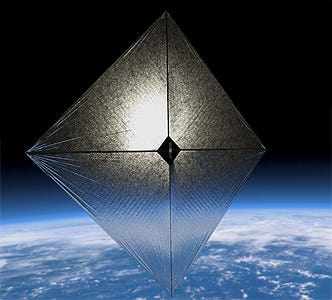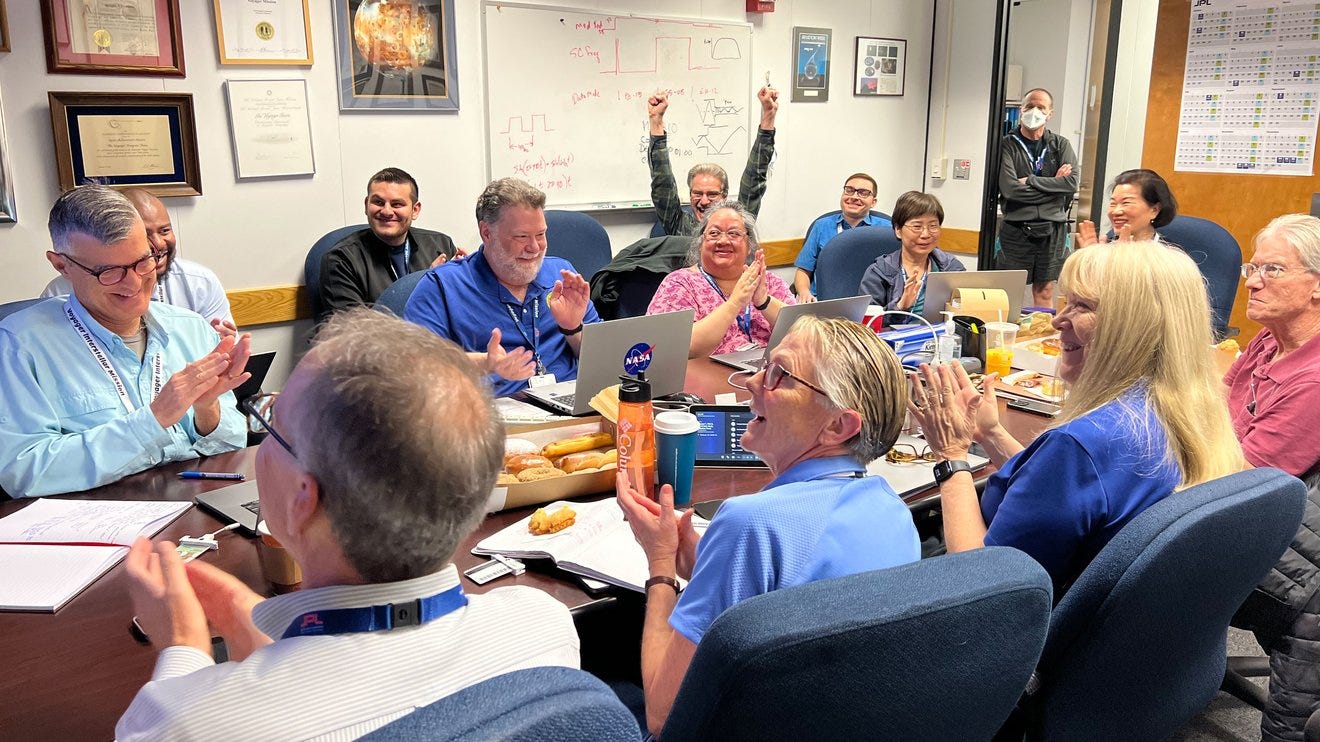🚀NDSS Newsletter - April 2024
The New Delhi Space Society presents the latest happenings in everything space!
Hello, fellow space enthusiast! 👋
Welcome to the April 2024 edition of this newsletter!
Before we begin, let us introduce ourselves! 📡
The New Delhi Space Society (NDSS) is a non-profit organization and functions as a chapter of the National Space Society (NSS). It was founded in 2018, seeing the level of enthusiasm in New Delhi students about space exploration and the lack of resources for this enthusiasm. Consisting of avid outer-space aficionados, we aim to make space an accessible resource for everyone. 📰
In pursuit of the aforementioned goal, we came up with this newsletter - a unique way for us to share our passion with you. Offering interesting nuggets of space news goodness, the newsletter promises to broaden your knowledge about humanity and its experiences with(in) the cosmos, whilst also bringing new opportunities for readers, all one small step at a time. 👨🚀🌕
Now, dear reader, let’s dive right in!
What’s new❓
From harnessing the sun to re-establishing communications with an old acquaintance, the industry saw some very interesting stuff recently!
Find more below!
Highlights:💡
NASA’s ACS3 Solar Sail Mission is ready for launch with Rocket Lab. ⛵
The James Webb Space Telescope might have found an exomoon orbiting a brown dwarf! ⭐
Skyroot Aerospace tests the second stage of their Vikram-1 vehicle with success. 🚀
ISRO aims to make all of their forthcoming space missions “debris-free”. ♻️
— Editor’s Pick:📌
Voyager 1 re-establishes communications with Earth after over 5 months! 📶
More to know:🔍
Solar Sails and Rocket Lab:
It would probably be hard for most people to believe that solar sails are no longer just a work of fiction. However, since the IKAROS mission in 2010, there have been quite a few missions exploring the technology. NASA’s Advanced Composite Solar Sail System, or ACS3 for short, is the latest addition to that list. ☀️

The mission, as the name suggests, seeks to use composite materials to test out Solar sail technology. Solar sails function by using radiation pressure from the Sun, which exerts a slight yet harnessable force on the sails, acting as a form of propulsion. 🔥
The ACS3 mission is scheduled to be launched no earlier than April 24. Rocket Lab enters the picture as they are going to be launching the spacecraft aboard their Electron rocket. 🚀
What is very special about the mission is that the approximately seven meters worth of deployable booms will be contained in a form factor so compact that it could fit in your hand. Here is to hoping for its success! 🛰️
A Brown Dwarf, perhaps with an Exomoon?
The James Webb Space Telescope certainly doesn’t fail when it comes to its endless spectacular discoveries. It most recently has come across a rather interesting series of methane emissions, that have been traced to a brown dwarf, or a ‘failed star’. While these emissions were expected, the glowing aurorae formed definitely weren’t. 💡

The cold brown dwarf W-1935, located 47 light-years away and originally discovered in 2019, surprised researchers by releasing infrared light, creating the appearance of glowing aurorae, contrary to the prior expectations of the dwarf not being warm enough to do so. 👀
What is even more exciting is that the lack of an actual star in the vicinity seems to suggest there might be a hidden exomoon causing the generation of the aurorae. With no known exomoons having been discovered yet, this finding might just have led us to the brink of a new discovery altogether! 🌙
Stage-2 test of the Vikram 1 succeeds:
After the organization’s pathbreaking launch of Vikram S made it the first private Indian company to reach space in late 2022, the Vikram 1 launch vehicle has been under development by Skyroot Aerospace, and it is also just as promising. Most recently, on March 27, Stage-2 of the launch vehicle, dubbed Kalam-250, was test-fired for its viability to propel the rocket through the upper atmosphere and into outer space. 🌌

The test was a resounding success. It marked the largest successful test of such a component by a private agency in the Indian space sector. The 85-second test, at peak performance, saw the thruster generate a force of 186 kilo-newtons. It is believed that this thrust will more than suffice for the needs of Vikram-1, and will hopefully also, literally and figuratively, propel the company to its next major achievement of successfully launching Vikram 1. 👍
Skyroot Aerospace is a private-sector startup for building powerful rockets that take payloads to space. They are a forerunner in what can be called the Indian space race, and a successful test of such a powerful stage with good output parameters is a major milestone in the greater development of private-sector rocket systems in India. 📈
ISRO aims to become “debris-free”:
Space debris continues to be a growing problem for upcoming space missions, and the Indian Space Research Organisation has decided to undertake an endeavor to combat the same. The agency aims to have zero space debris in orbit by 2030. ♻️

The impact of space debris has been felt more strongly in recent years. Whether it was the incident with the International Space Station’s CanadaArm2 in 2021 or the much more recent incident with NASA’s TIMED spacecraft almost getting struck in April by a defunct Russian spy satellite, as more and more spacecraft take to Low Earth Orbit, there will be a larger number of such incidents. ⚠️
ISRO’s solution majorly involves a pledge to try its best to ensure all of its vehicles launched from here on out are capable of being de-orbited once their service lifespan is over. Additionally, the agency is exploring methods to safely land their existing spacecraft once they retire as well.💫
This move will hopefully result in the more widespread adoption of such methods to ensure the safe disposal of space debris from orbit, which is without a doubt something that everyone will find that be a welcome change. 🌍
Editor’s Pick:📌
Getting back in touch with Voyager 1:
There is nothing as fascinating as the recent events with humanity’s furthest representation in the universe away from Earth, at an unmatched distance of over 24.4 billion kilometers (and increasing!) away in interstellar space. Armed with a Golden Record that effectively represents all of us back here on Earth, Voyager 1 was launched in 1977 to explore the depths of space that no one had ever before. However, on November 14, 2023, a major issue came to light — a segment of the code in the probe’s flight data subsystem errored, and hence the spacecraft failed to send back meaningful communications thereafter. 😔

As space enthusiasts all over were surprised by the news, engineers at NASA’s Jet Propulsion Laboratory immediately got to work in an attempt to recover communications with the historic probe. 🔧
Again, one cannot fathom the sheer distance over which this problem was being remotely handled — the speed of light itself, and thus any corrective communication instructions, would take an unmatched time of over 22 hours and 30 minutes to go one way between the Earth and Voyager 1. 🐢
As days turned into weeks and weeks turned into months, the complex fixes were slowly, but surely, sent over to Voyager 1. Relief finally came on April 20, as the spacecraft confirmed its health and status properly for the first time in over 5 months, signaling itself as okay. The image below encapsulates the Voyager Flight Team’s reaction to the news as much as it captures the reactions of space enthusiasts around the world. 🎉

Opportunities: ❗❗
Job Alerts
Associate Manufacturing Engineer, Boeing (Bengaluru, Karnataka, India)
Staff Engineer, Mechanical Analysis, GE Aerospace (Bengaluru, Karnataka, India)
Quality Engineer (Composites), Skyroot Aerospace (Hyderabad, Telangana, India)
Internships
Aeronautical/AME Internship, Camp Systems International (Hyderabad, Telangana, India)
Business Development Internship, Aviotron Aerospace (Noida, Uttar Pradesh, India)
Written by Amartya Bagchi with inputs from Ashvin Verma on behalf of the New Delhi Space Society.


